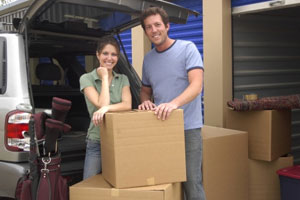Storing & Packing Tips
 Plan ahead. Keep your frequently used items at the front of your unit where you can get at them easily.
Plan ahead. Keep your frequently used items at the front of your unit where you can get at them easily. - Map It. As you move into your storage space, make a simple drawing that shows where items are placed.
- Cover up. Protect your furniture, including mattresses and box springs, with covers designed for the item.
- Think vertical. Make best use of your storage area by stacking to the ceiling, working from heaviest items on the bottom to lightest items on top.
- Don’t over-reach. Use a stool to stack and reach items stored above your head.
- Optimize your space. Break down any furniture that has removable legs, leaves or other parts. Stack chairs seat-to-seat with towels or blankets between them.
 Multi-task. Use your refrigerator or other appliances to store things like linens – even books or CDs. Wedge the door of any appliances open so air can circulate inside them.
Multi-task. Use your refrigerator or other appliances to store things like linens – even books or CDs. Wedge the door of any appliances open so air can circulate inside them. - Take a breath. Leave a little space between the walls of your unit and your stored items to allow for ventilation.
- Tool up. Shovels, hoes, rakes and hoses can be stored together in empty trash cans. Stack extra cans inside one another.
- Clear the air. If you’re storing a gas-powered lawnmower or leaf blower, you must drain the tank for safety.
- Be prepared. Keep an extra emergency preparedness kit in your storage unit. If your home is inaccessible, you’ll have a second supply resource.
- Shop first. Purchase all the materials and supplies you need before you start: boxes, tape, packing materials, markers, furniture covers and so on. Remember, Oceana Self Storage sells everything you need.
- Label, label, label. Mark every box with its contents, and keep a written inventory as you pack.
- Use the right box. Use large boxes for light items (linens, pillows, lamps) and smaller boxes for heavier items (books, CDs).
 Take care. Pack small things carefully into boxes with appropriate packing materials. Resist the temptation to toss things into a garbage bag; they risk damage from knocks or bumps and mildew from lack of ventilation.
Take care. Pack small things carefully into boxes with appropriate packing materials. Resist the temptation to toss things into a garbage bag; they risk damage from knocks or bumps and mildew from lack of ventilation. - This side up. If you combine different weights of items in one box, always put the heavier things on the bottom and mark the box “this side up.”
- Don’t overload. Packed boxes should only weigh as much as you can lift without straining – for most people, less than 40 pounds.
- Tape it up. Make sure all your packed boxes are securely sealed with packing tape, with the tops flat (to make it easier to stack them).
- Hang it up. Use a wardrobe box to hang clothing, draperies and other fabrics that need to breathe and be kept crease-free.
- Break it down. Disassemble bed frames and lash them together with tape or twine. Use small plastic bags to store screws and bolts and tape them to the frame that they belong to.
- Respect breakables. Wrap dishes and glassware individually, and pad the box with packing paper or bubble wrap.
- Coat your wood furniture in a heavy coat of wax or polish and use old sheets or cloth to cover it rather than plastic.
- Metal can be coated with an oil to help prevent rust and oxidation.
- Pack heavy items such as books in smaller boxes and keep weight per box under 30 pounds.
Larrymore Apartment Communities
 |
 |
 |
 |
 |
